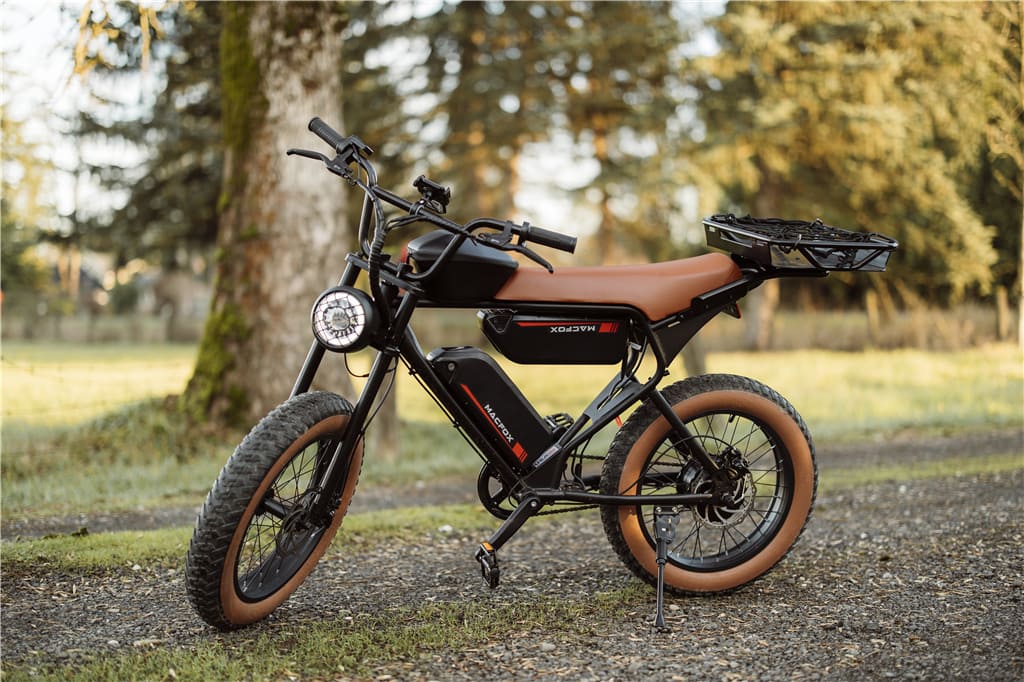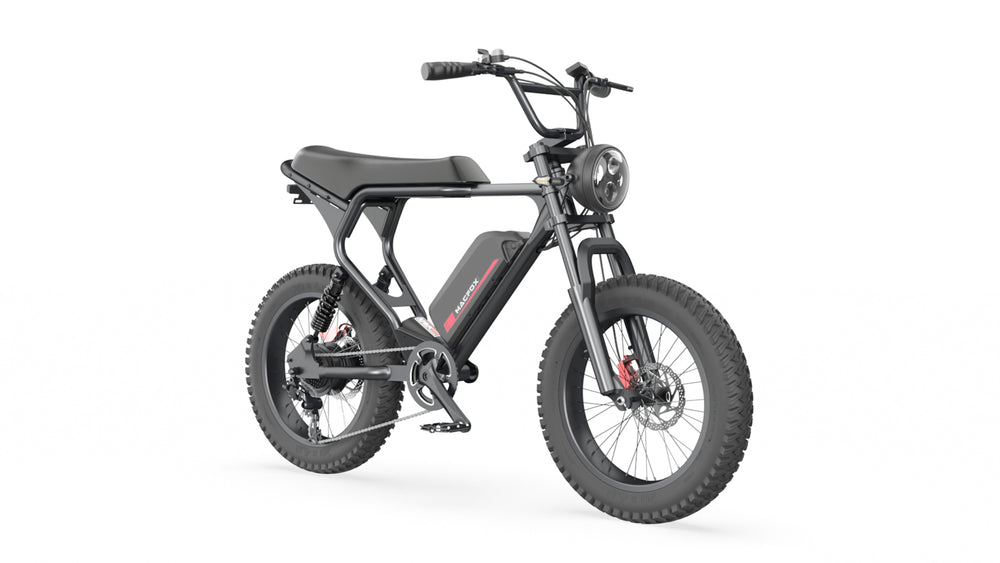Electric bikes (e-bikes) have become an increasingly popular transportation solution. From commuting and exploring rugged mountain trails to leisurely rides around town or simply leisurely commutes, an e-bike has something to suit your transportation needs, and this comprehensive guide will take you through different types of electric bikes as well as critical considerations before purchasing and maintaining tips to help make an informed decision.
Understanding Electric Bikes

Electric bikes (e-bikes) are bicycles equipped with an electric motor to aid their propulsion. This motor may be activated either through pedaling or throttle control; understanding these fundamentals of e-bikes is vital for anyone considering making a purchase decision, as this knowledge affects everything from riding comfort and practicality in various environments.
The Basics of Electric Bikes
E-bikes are designed to simplify cycling in challenging conditions, such as hills or long distances, by combining traditional mechanical components of a regular bicycle with elements of an electric system -- such as motor, battery, and controller -- that reduce the required pedal effort. Their electric motor also allows people of varying fitness levels to participate by providing reduced effort needed to pedal while extending rider endurance without fatigue.
There are two primary types of e-bike systems:
-
Pedal Assist System (PAS): With this system, the motor activates only when pedaling occurs to boost your efforts. This creates a more natural and intuitive cycling experience in which electric assist feels like an organic part of pedaling itself. The amount of assist is generally determined by force applied to pedals and can usually be adjusted via handlebar controls.
-
Throttle-based: Some e-bikes include throttle mechanisms that enable riders to propel the bike without pedaling at all, similar to riding a motorcycle or scooter. This type benefits those who would rather ride without exerting physical effort; however, this style typically uses more battery power quickly.
Key Components of Electric Bikes
Motor: The motor is a pivotal component and can be located in one of three places:
- Hub motor: Often found in the rear wheel, hub motors propel the bike using power directly applied to the wheel.
- Mid-drive motor: Located in the center of the bike frame near the bottom bracket, mid-drive motors drive the crank, instead of the wheel itself, offering better weight distribution and balance.
- Front hub motor: Less common, located in the front wheel, providing a pull effect that is somewhat different in handling.
If you want to compare e-bike motors, check out our article:《Comparing Hub Motor vs. Mid-Drive E-Bikes》
Battery: E-bike batteries provide the electrical energy needed to drive the motor. Their capacity (measured in watt-hours, Wh) varies significantly, directly influencing how far a single charge will take you on a single ride. Lithium-ion batteries are most popular due to their lightweight construction and efficient performance; however, they can sometimes be pricey options.
Controller: An e-bike's controller serves as the heart and soul of its electrical system. It regulates power transfer from battery to motor based on rider input, such as pedaling force in pedal-assist systems or throttle use. It controls how quickly power is applied to provide a smooth acceleration curve and avoid sudden motor activations jolts.
Understanding these fundamentals of electric bikes is vital for selecting an e-bike to meet your specific needs and maintaining it effectively. E-bike technology advances rapidly, making them increasingly attractive options for cyclists.
Types of Electric Bikes
Electric bikes today can suit various preferences, uses, and terrains. Each type of e-bike features specific attributes that optimize it for certain environments or activities; understanding these features can help you select an electric bike best suited to your intended use.
E-Bike Classifications
Electric bikes can generally be divided into three classes according to their motor capabilities and how they assist their rider:
-
Class 1: Pedal-Assist
- These bikes are equipped with a motor that provides assistance only when the rider is pedaling, and stops assisting when speeds reach 20 mph. This type is popular among commuters and recreational cyclists because it maintains the feel of a traditional bike while providing a boost.
-
Class 2: Throttle-Assisted
- Class 2 e-bikes feature a throttle that can propel the bike without pedaling, similar to a moped or scooter, up to a maximum speed of 20 mph. These are suitable for riders who may want the option to ride without exerting much physical effort.
-
Class 3: Speed Pedelec
- These bikes also provide pedal assistance but can reach higher speeds of up to 28 mph. They are often equipped with a speedometer and are favored by long-distance commuters and those who need to travel quickly and efficiently over greater distances.
Popular Types of Electric Bikes
-
Commuter E-Bikes: Engineered specifically for urban settings, commuter e-bikes feature features to increase practicality and comfort, such as lights, fenders, racks, and integrated locks that add convenience and ease of use.
-
Mountain E-Bikes (e-MTBs): These electric versions of traditional mountain bikes are constructed like traditional bikes but equipped with electric power, making them perfect for tackling challenging off-road trails.
-
Road E-Bikes: These lighter options are designed for speed and agility on paved roads, making them popular among fitness enthusiasts and road cyclists who wish to extend their riding range.
Specialty Electric Bikes
-
Cargo E-Bikes: With large cargo areas or baskets, cargo E-Bikes are perfect for transporting groceries, packages, or children to and from various errands without using your car as often.
-
Folding E-Bikes: These bikes combine the convenience of folding with electric power for compact storage solutions in tight spaces or on public transportation. They are perfect for commuters and small offices.
-
Fat Tire E-Bikes: Fat tire E-bikes are known for their wide, durable tires, which allow them to float over snowy paths, sandy beaches, or muddy terrain with ease. This makes these bikes great options for adventurers tackling various surface conditions.
Factors to Consider When Buying an E-Bike
Finding an electric bike requires more than simply selecting its type. Numerous key considerations will play an impactful role, ultimately impacting your satisfaction and the bike's performance.
Purpose and Use
Before purchasing an electric bicycle, first determine its primary purpose and use. For instance:
-
Commuting: Look for an e-bike equipped with features such as racks, lights, and fenders for optimal commuting experiences.
-
Recreation: Comfort may be key; step-through frames or those offering improved suspension could be ideal.
-
Off-road: To travel safely off-road, you will require a strong frame as well as a potentially more powerful motor.
Battery Life and Range
One of the most critical aspects of an e-bike is its range, or how far you can travel on a single charge. Factors that affect range include:
- Battery capacity: Measured in watt-hours (Wh), a higher number means a larger capacity and longer range.
- Riding conditions: Hills, headwinds, and carrying heavy loads can reduce range.
- Rider input: More pedaling can extend the battery life.
Motor Type and Power
The motor's positioning and power dramatically impact how a bike rides: its placement can alter how the bike maneuvers.
-
Hub Motor Vs Mid Drive Motor: Hub motors tend to be cheaper and simpler; however, they may unbalance a bike. Mid-drive motors, on the other hand, are designed for enhanced weight distribution, which is ideal for hills.
-
Wattage: Increased wattage means increased power, which is useful when climbing hills or carrying loads, but may drain your battery faster.
When making your selection, consider weight, availability of replacement parts, and manufacturer warranty. Test rides should also be undertaken to get acquainted with different e-bike models and ensure they fit comfortably and fulfill expectations.
Related Reading: How To Spot The Best Value Electric Bikes?
Best Electric Bikes for Different Needs
Finding the ideal electric bike depends on your unique needs and circumstances. Different kinds of e-bikes have been designed specifically for various activities ranging from urban commuting to mountain biking. Here is a selection of some of the top e-bikes suited for each purpose:
Best for Urban Commuting
Urban commuters require electric bicycles that are efficient, comfortable, and equipped with features to facilitate daily travel. Ideal commuter e-bikes typically feature:
- Integrated lighting systems for safe travel during early mornings or late evenings.
- Built-in locks for security.
- Rear racks for carrying bags or groceries.
- Puncture-resistant tires to minimize maintenance.
Like the Macfox X1, this bike offers excellent reliability in a beautiful and user-friendly design.
Macfox X1
$999.00 – $1,497.00Best for Mountain Biking
Mountain biking enthusiasts require e-bikes capable of handling rough terrain while providing ample power for climbing steep trails. Critical features for mountain e-bikes include:
- Robust suspension systems to handle bumps and jumps.
- Powerful motors to assist on steep ascents.
- Durable, wide tires for superior traction.
The Macfox X2 stands out in this category, offering top-notch technology and build quality to conquer challenging trails.
Macfox X2
$1,699.00 – $2,198.00Best for Long-Distance Touring
Touring e-bikes must boast long battery lives, comfortable seats, and adequate storage options for long-distance touring. Ideal touring e-bikes include:
- Large capacity batteries for extended range.
- Comfortable seating and frame geometry for long periods of riding.
- Cargo racks and panniers for storing gear and supplies.
Maintenance and Care of Electric Bikes
Preventative maintenance on an electric bike is critical for peak performance, extending its lifespan and increasing enjoyment over many years. Here are some essential maintenance tips:
Routine Maintenance
-
Battery Care: For optimal battery care, store the battery in a cool and dry environment and keep it charged between 30% and 60% when not being used regularly. Avoid completely depleting it, as this can shorten its lifespan.
-
Tire Pressure: Maintain the ideal tire pressure to maximize battery performance and avoid flats. Chain and Gears: To reduce wear on chains and gears and ensure smooth shifting action. Regularly inspect, lubricate, clean, and lube them to reduce wear on gears and chains.
-
Brakes: Regularly check brake pads for wear and ensure all brake components are functioning appropriately, particularly since e-bikes tend to be heavier and faster than their traditional counterparts, making effective braking crucial.
Troubleshooting Common Issues
-
Battery issues: If your battery seems to no longer hold its charge as before, it might require replacement or professional servicing.
-
Motor problems: Any unusual noises or lack of smooth assistance could indicate issues with the motor; sometimes, simply resetting its computer system may help resolve these issues.
-
Electronic malfunctions: When errors or failure of electronic components occur, professional assessment should always be sought as soon as possible. Check all connections and clean contacts before working on these parts.
Professional inspections should take place annually depending on how often an e-bike is used, with many bike shops now providing dedicated e-bike maintenance and repair services.
Selecting an e-bike that best meets your needs and following a regular maintenance regimen are essential in realizing its full potential - assuring it remains an enjoyable mode of transport for years to come.

Advantages of Owning an Electric Bike
Electric bikes provide numerous benefits beyond mere transportation. These advantages range from improvements in physical health, environmental impact, and economic savings, making e-bikes an appealing option for various groups of people. Here is a closer look at these key benefits of owning an electric bike:
Health Benefits
-
Increased Physical Activity: While e-bikes provide pedal assistance, they still encourage physical activity—particularly beneficial to those who might find traditional biking too strenuous. Studies have demonstrated that people who ride e-bikes more frequently gain more physical fitness per week than traditional bicycle riders.
-
E-bikes Are Accessible to More People: E-bikes make cycling accessible to people of all ages and fitness levels, especially seniors or those with physical limitations; particularly helpful are their pedal assist functions to reduce strain on knees and thighs.
-
Mental Health Benefits: Cycling offers numerous mental health advantages. Like any form of moderate exercise, cycling can reduce stress and depression. E-bikes make cycling part of the daily routine more efficient, further strengthening overall mental well-being.
Environment Benefits
Reduced Carbon Footprint: E-bikes consume less energy and produce fewer emissions than motor vehicles, so you can significantly lower your carbon footprint by opting for bike rides instead of car trips.
Less Traffic Congestion: E-bikes help alleviate traffic congestion by decreasing overall car volumes on the road, which in turn decreases urban congestion and related environmental concerns such as noise pollution and vehicle emissions.
Energy Efficiency: Electric bikes are extremely energy-efficient vehicles, consuming only a fraction of the power consumed by cars, motorcycles, or public transportation systems. This makes them more sustainable options for short—to moderate-distance travel.
Environmental Benefits
-
Cost-Effective: When considering the high costs associated with fuel, insurance, and regular car maintenance, purchasing and maintaining an e-bike becomes a cost-effective solution for daily commutes or short trips.
-
No Parking Fees or Fines: Finding parking can be a costly and frustrating endeavor in many cities. E-bikes, however, are easy to park and typically free from the parking costs and fines associated with larger vehicles.
-
Lower Depreciation Costs: E-bikes depreciate slower than cars and retain their value better over time.
Practical and Convenient
- Ease of Travel: E-bikes make it easier to cover longer distances or hilly terrains with less effort. This capability allows you to arrive at your destination without the sweat and fatigue associated with traditional biking.
- Multi-modal Travel: Many e-bike designs are foldable, which facilitates easy carrying and storage, making them perfect for combining cycling with public transport. This versatility enhances mobility, especially in urban environments.
- Increased Range and Speed: With the support of an electric motor, e-bikes offer a greater range and can maintain higher speeds more effortlessly compared to traditional bicycles. This makes them an excellent option for both urban commuters and leisure riders.
Owning an electric bike presents a versatile, health-conscious, and environmentally friendly alternative to traditional motorized transport. It not only supports a sustainable lifestyle but also provides practical benefits that improve daily travel. Whether you are commuting, running errands, or simply enjoying the outdoors, an e-bike can enhance your mobility and contribute to a healthier lifestyle.
Conclusion
Electric bikes (e-bikes) offer an environmentally friendly solution to meet various transportation needs, from urban commuting to mountain biking. E-bikes combine traditional cycling with motorized assistance to make them accessible to a broader range of people, including those with physical limitations and older people. There are various types and classifications of e-bikes explicitly designed to meet multiple uses or environments. Key factors when purchasing an e-bike include its intended purpose of use, battery life, motor type, and maintenance schedule. Routine checks should also be undertaken on battery levels, tires, and electrical systems for optimal functioning and results. Benefits associated with owning an e-bike span health, environmental, and economic aspects; increased physical activity levels, lower carbon emissions, and lower operating costs compared to cars are just some of the advantages of owning one.
FAQs
What is the approximate lifespan of an electric bike battery before needing replacement?
E-bike batteries typically last three to five years, depending on usage, care, and charge cycles.
Can electric bikes be ridden safely in rainy or wet weather conditions?
Electric bikes can be safely used in the rain, as most models feature water-resistant components. However, it's essential to avoid submerging your bike entirely and keep its electrical parts dry and dust-free.
Are electric bikes much more costly than regular bikes?
Electric bikes may cost more than their traditional counterparts due to the advanced technology they incorporate, such as motors and batteries; however, their long-term savings on transportation costs often outweigh initial investments.



















